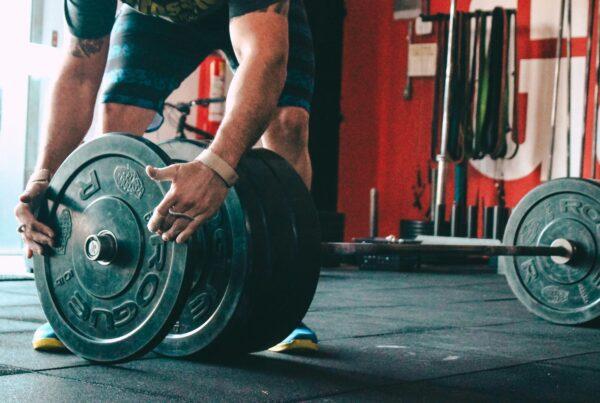Welcome to the ultimate guide to building muscle! If you’re ready to transform your physique and achieve impressive muscle growth, you’ve come to the right place. This comprehensive guide will provide you with essential tips and expert advice on the basics of muscle growth, nutrition for muscle building, protein intake, and the concept of progressive overload.
Building muscle is not just about lifting weights. It’s a well-rounded approach that involves fueling your body with the right nutrients, stimulating your muscles through targeted workouts, and allowing them to recover properly. By understanding the key principles of muscle growth, you can optimize your efforts and achieve remarkable results.
Key Takeaways:
- Proper nutrition is crucial for muscle building.
- Focus on consuming adequate protein to support muscle synthesis.
- Progressive overload is necessary to stimulate muscle growth.
- Targeted workouts should include compound and isolation exercises.
- Rest and recovery are essential for muscle growth and injury prevention.
Nutrition for Muscle Building
Proper nutrition is crucial for effective muscle building. The right balance of macronutrients provides the necessary fuel for muscle growth and aids in post-workout recovery. To optimize your nutrition for muscle building, it is essential to focus on protein intake, carbohydrate consumption, and healthy fats.
Protein Intake
Protein is the building block of muscle, making it an essential nutrient for muscle growth. Aim to consume an adequate amount of protein with each meal to support muscle synthesis. The recommended protein intake for muscle building is generally 1.6 to 2.2 grams per kilogram of body weight. Good sources of protein include lean meats, poultry, fish, eggs, dairy products, legumes, and plant-based proteins like tofu and tempeh.
Carbohydrates and Healthy Fats
Carbohydrates provide the energy needed to fuel intense workouts and replenish glycogen stores in your muscles. Including complex carbohydrates like whole grains, fruits, and vegetables in your diet ensures a steady supply of energy. Additionally, healthy fats are important for hormone production and overall health. Incorporate sources of healthy fats such as avocados, nuts, seeds, and olive oil into your meals to support muscle growth.
Timing Meals and Snacks
Timing your meals and snacks strategically can enhance muscle growth and recovery. Consuming a balanced meal or snack containing protein and carbohydrates before and after your workouts provides essential nutrients at the right time. Pre-workout, this helps provide energy and promote muscle protein synthesis. Post-workout, it aids in muscle repair and glycogen replenishment.
Here’s an example of a sample meal plan for muscle building:
| Meal | Time | Food |
|---|---|---|
| Breakfast | 8:00 AM | Scrambled eggs, whole wheat toast, and avocado |
| Snack | 10:30 AM | Greek yogurt with berries |
| Lunch | 1:00 PM | Grilled chicken breast, quinoa, and steamed vegetables |
| Pre-workout Snack | 4:00 PM | Rice cake with peanut butter |
| Post-workout Meal | 6:00 PM | Salmon, sweet potatoes, and roasted asparagus |
| Dinner | 8:00 PM | Lean beef, quinoa, and mixed greens salad |
| Snack | 10:00 PM | Protein shake with almond milk |
Rest and Recovery
“Rest is an essential component of muscle building. It is during rest that your muscles repair and grow stronger.”
It’s important to prioritize rest and recovery to maximize muscle growth. Make sure to allow your body enough time to recover between intense workouts. This may include incorporating rest days into your training schedule or engaging in active recovery activities like stretching or low-intensity workouts. Additionally, getting enough sleep is critical for muscle growth and overall health. Aim for 7-9 hours of quality sleep each night to optimize your body’s recovery and muscle-building processes.
Incorporating proper nutrition, protein intake, and adequate rest and recovery into your muscle-building journey will help you achieve the best results. Prioritize these elements, and you’ll be well on your way to reaching your fitness goals.
Effective Workout Techniques
The right workout techniques play a crucial role in maximizing your muscle growth potential. By incorporating a combination of compound exercises and isolation exercises into your routine, you can target multiple muscle groups and achieve well-rounded results.
Compound exercises are key players in any muscle-building program. They involve movement at multiple joints, activating several muscle groups simultaneously. This not only enhances overall strength but also stimulates significant muscle growth. Compound exercises offer various benefits, including:
- Efficiency: With compound exercises, you can work multiple muscle groups in less time, making your workouts more efficient.
- Functional strength: These exercises mimic real-life movements, improving your ability to perform everyday tasks and sports activities.
- Increased calorie burn: Due to their high-intensity nature, compound exercises can help you burn more calories during and after your workout.
Examples of compound exercises include:
| Exercise | Muscle Groups |
|---|---|
| Bench Press | Chest, Shoulders, Triceps |
| Squat | Quadriceps, Hamstrings, Glutes |
| Deadlift | Back, Glutes, Hamstrings |
![]() While compound exercises provide a solid foundation for muscle growth, incorporating isolation exercises into your routine can target specific muscle groups and help develop individual muscles. Isolation exercises are best utilized as complementary exercises to compound movements, allowing you to refine muscle definition and address any imbalances.
While compound exercises provide a solid foundation for muscle growth, incorporating isolation exercises into your routine can target specific muscle groups and help develop individual muscles. Isolation exercises are best utilized as complementary exercises to compound movements, allowing you to refine muscle definition and address any imbalances.
Here are a few examples of isolation exercises:
- Bicep Curls: Targets the biceps for greater arm definition.
- Lateral Raises: Isolates the deltoids, enhancing shoulder shape and strength.
- Leg Extensions: Focuses on the quadriceps for stronger and more defined legs.
By combining compound exercises and isolation exercises strategically, you can challenge your muscles from different angles and stimulate maximum growth.
The Importance of Workout Frequency and Intensity
Aside from exercise selection, two crucial factors that greatly impact muscle growth are workout frequency and intensity.
Workout frequency refers to the number of times you train a specific muscle group or perform a full-body workout within a given timeframe. Consistency is key when it comes to building muscle, as regular training sessions ensure a continuous stimulus for growth and adaptation. Aim to work each muscle group at least twice a week to optimize results.
Workout intensity refers to the level of effort and challenge you apply during your training sessions. To promote muscle growth, it’s important to gradually increase the intensity of your workouts over time. This can be achieved through progressive overload, which entails progressively increasing the weight, reps, or sets in your exercises.
“To see changes in your muscles, you need to push them beyond their comfort zone. Embrace the principle of progressive overload and continually challenge yourself to lift heavier weights, perform more reps, or increase the difficulty of your exercises.”
Remember, always prioritize proper form and technique to reduce the risk of injury when increasing workout intensity.
Next, we will explore beginner and advanced workout plans tailored to different fitness levels, providing you with valuable guidance to accelerate your muscle-building journey.
Beginner and Advanced Workout Plans
Whether you’re a beginner or an advanced trainer, having a well-structured workout plan is essential for building muscle. This section provides sample workout plans for both beginners and advanced individuals, outlining exercises, sets, and reps. It also explores the differences between gym training and home workouts, offering insights into equipment options and training techniques for each setting.
Beginner Muscle Building Workout Plan
If you’re new to muscle building, it’s important to start with a beginner workout plan that focuses on developing a foundation of strength and proper form. Here’s a sample beginner workout plan to kickstart your journey:
| Exercise | Sets | Reps |
|---|---|---|
| Squats | 3 | 10-12 |
| Push-Ups | 3 | 10-12 |
| Lat Pulldowns | 3 | 10-12 |
| Dumbbell Shoulder Press | 3 | 10-12 |
| Hamstring Curls | 3 | 10-12 |
| Plank | 3 | 30 seconds |
Remember, as a beginner, it’s crucial to focus on proper form and gradually increase the weights and intensity as your strength improves.
Advanced Muscle Building Workout Plan
If you’re an experienced lifter looking to take your muscle-building journey to the next level, this advanced workout plan is designed to challenge your muscles and promote further growth:
| Exercise | Sets | Reps |
|---|---|---|
| Deadlifts | 4 | 6-8 |
| Bench Press | 4 | 6-8 |
| Pull-Ups | 4 | 6-8 |
| Overhead Press | 4 | 6-8 |
| Barbell Lunges | 4 | 6-8 |
| Weighted Plank | 4 | 30 seconds |
This advanced workout plan incorporates heavier weights and lower reps to challenge your muscles and stimulate growth. Remember to always prioritize proper form and consult with a trainer if you’re unsure about any exercise.
Gym Training vs. Home Workouts
Deciding whether to train at a gym or work out at home is a personal choice that depends on factors such as convenience, equipment availability, and personal preference. Here are some key differences between gym training and home workouts:
“Gym Training allows access to a wide range of equipment and professional guidance, which is beneficial for advanced lifters seeking variety and specific muscle targeting. On the other hand, home workouts offer convenience and flexibility, making it easier to fit exercise into a busy schedule.”
Ultimately, the choice between gym training and home workouts depends on your individual needs and preferences. Consider factors such as your fitness goals, budget, and available space when making a decision.
Tracking Progress and Measuring Body Composition
Monitoring your progress is crucial for staying motivated and adjusting your approach as needed. In order to effectively track your muscle-building journey, this section explores various methods for measuring progress and assessing changes in body composition.
Recording Measurements
One of the most straightforward ways to track your progress is by regularly recording key measurements. This can include measuring your body weight, girth measurements of specific muscle groups, and keeping track of your body fat percentage. By consistently tracking these measurements, you can identify trends and determine if your training and nutrition plan is yielding the desired results.
Taking Progress Photos
Progress photos serve as visual evidence of your body’s transformation. Take front, back, and side photos in consistent lighting and poses every few weeks to observe changes in muscle definition and overall physique. Comparing these photos side by side can provide motivation and encouragement to continue pushing forward.
Keeping a Workout Journal
A workout journal is an invaluable tool for tracking your progress in the gym. By noting down the exercises, sets, reps, and weights used during each workout, you can easily gauge your strength and track improvements over time. A workout journal also allows you to identify patterns or plateaus, enabling you to make necessary adjustments to your training program.
“Consistency is key when it comes to tracking progress. By monitoring your measurements, taking progress photos, and keeping a workout journal, you have tangible evidence of your hard work and can make informed decisions to reach your muscle-building goals.”
Measuring Body Composition
Measuring body composition involves assessing the proportions of fat, muscle, bone, and water in your body. Two common methods used to measure body composition are:
- Bioelectrical Impedance Analysis (BIA): This method uses a scale or handheld device that sends a low-intensity electrical current through the body to estimate body fat percentage.
- Dual-energy X-ray absorptiometry (DXA): DXA scans provide a comprehensive analysis of body composition by measuring fat, muscle, and bone density. This method is more accurate but generally requires a medical facility.
Evaluating your body composition can provide insights into the effectiveness of your muscle-building efforts. By regularly tracking your body fat percentage and muscle mass, you can tailor your nutrition and training plan to optimize your progress.
| Method | Accuracy | Convenience |
|---|---|---|
| Bioelectrical Impedance Analysis (BIA) | Moderate | High |
| Dual-energy X-ray absorptiometry (DXA) | High | Low |
Supplements for Muscle Building
While having a solid nutrition plan is crucial for optimizing muscle growth, some individuals may consider incorporating supplements to further enhance their results. Supplements can provide additional support by supplying key nutrients and aiding in recovery. It is important to note that supplements should complement a well-rounded diet and exercise regimen, not replace them.
Here are some popular supplements commonly used for muscle building:
-
- Protein Powders:
Protein powders, such as whey, casein, and plant-based options like soy and pea protein, are convenient sources for meeting your daily protein requirements. They can be easily added to shakes, smoothies, or meals and are especially beneficial for individuals who struggle to consume enough protein through whole foods alone. Protein powders provide essential amino acids that are crucial for muscle repair and growth.
-
- Creatine:
Creatine is a naturally occurring compound found in muscle cells. Supplementing with creatine can enhance your ability to produce energy during intense workouts, which can lead to increased strength and power. It may also aid in muscle recovery and reduce fatigue. Creatine monohydrate is the most researched and commonly used form of creatine.
-
- Branched-Chain Amino Acids (BCAAs):
BCAAs are a group of essential amino acids that include leucine, isoleucine, and valine. These amino acids play a crucial role in muscle protein synthesis, which is essential for building and repairing muscle tissue. BCAAs can be consumed as supplements and are often taken before or during workouts to support muscle recovery and reduce muscle breakdown.
It’s worth noting that while supplements can be beneficial, they are not magic pills. They work best when combined with a proper nutrition plan and consistent training regimen. It’s always recommended to consult with a healthcare professional or a registered dietitian before starting any new supplement.
Tips for Success and Staying Motivated
Building muscle is a journey that requires commitment and perseverance. Along the way, you may encounter challenges and moments of doubt, but staying motivated is key to reaching your muscle-building goals. Here are some practical tips to help you succeed and stay motivated throughout your transformative journey:
- Set Clear Goals: Start by defining your muscle-building goals clearly. Whether you want to increase muscle mass, improve strength, or achieve a specific physique, having a clear vision will give you direction and purpose.
- Celebrate Milestones: Recognize and celebrate your achievements along the way. These milestones can be anything from completing a challenging workout routine to reaching a personal record in weightlifting. Celebrating these victories will keep you motivated and reinforce your progress.
- Find a Workout Buddy: Having a workout partner can provide accountability and support. Partnering up with someone who shares your goals can make workouts more enjoyable and push you to give your best effort.
- Mix Up Your Routine: Plateaus can happen, and they can be demotivating. To overcome them, try incorporating new exercises, changing workout intensity, or exploring different training methods. Variety keeps things interesting and helps you continuously challenge your muscles.
- Visualize Success: Create a mental image of yourself achieving your muscle-building goals. Visualizing your success can increase motivation and confidence, making it easier to stay committed to your training and nutrition plan.
- Stay Consistent: Consistency is key in any fitness journey. Stick to your workout schedule, adhere to your nutrition plan, and make fitness a priority in your daily life. Small, consistent efforts over time will yield significant results.
- Maintain a Positive Mindset: Your mindset plays a critical role in your success. Instead of focusing on setbacks or challenges, adopt a positive attitude and embrace the journey. Believe in yourself and your ability to overcome obstacles.
Remember, building muscle takes time and dedication. By setting clear goals, celebrating milestones, and maintaining a positive mindset, you can stay motivated and achieve the physique you desire.
Stay Motivated with Inspiring Quotes:
“Success is the sum of small efforts repeated day in and day out.” – Robert Collier
“The only place where success comes before work is in the dictionary.” – Vidal Sassoon
“Believe in yourself and all that you are. Know that there is something inside you that is greater than any obstacle.” – Christian D. Larson
Now that you have the tools to succeed and stay motivated, let’s explore the next section, which focuses on tracking your progress and measuring your body composition.
Conclusion : Guide to Building Muscle
In conclusion, building muscle is a multifaceted process that requires dedication and consistent effort. By following the expert tips and advice provided in this ultimate guide, you can embark on a transformative journey to unlock your full muscular potential and achieve the physique you desire.
Proper nutrition is the foundation of muscle growth, and it’s essential to fuel your body with the right nutrients, including an adequate protein intake, healthy carbohydrates, and beneficial fats. Combine this with targeted workouts that focus on both compound and isolation exercises, ensuring proper workout frequency and intensity to challenge your muscles and promote growth.
Don’t underestimate the importance of rest and recovery. Your body needs time to repair and rebuild the muscles you’ve worked so hard to stimulate. Prioritize getting enough sleep, as it plays a crucial role in muscle growth and overall physical performance.
Remember, building muscle is a personal journey, and staying motivated is key. Set clear goals, track your progress, and celebrate milestones along the way. With consistency, perseverance, and a positive mindset, you can turn your muscle-building aspirations into reality. So, why wait? Start your muscle-building journey today and witness the incredible changes that await you.








